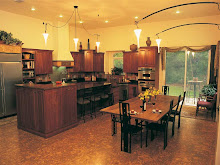Cork Flooring Information
- Cork flooring's main ingredient is cork bark, from the cork oak tree. The cork bark is harvested from cork oaks in Southern Europe, mainly Portugal. The process begins with the gathering, cleaning and boiling of the cork. The cork is then put through a grinding process and afterward a resin is mixed with the ground cork. The material is then pressed into sheets and then baked in a kiln. The heating process caramelizes the natural sugars in the cork which colors the cork. Heating times are altered to adjust the final color of the cork flooring. Additional dyes can be added to change the final color. Cork is sold in sheets, planks and tiles.
- Cork harvesting is done by hand and is a regulated commercial enterprise. The oak trees
being harvested must be at least 25 years old before being included in the harvest cycle. Removing the cork does not affect the tree's health and, in fact, the bark grows back in time and the tree stays healthy throughout the process. Cork harvesting is a highly renewable, "green" source of material. Cork trees being harvested today are in some cases 200 years old and have been harvested for more than a century. - The most common cork floor is a floating floor. A floating floor is made up of four layers of cork and is installed without the use of adhesives or glues. The first layer is the under-layer and is a low-density cork used to provide a base. The next layer is a stabilizing layer. This layer is high- or medium-density fiberboard, using a tongue and groove construction. The third layer is the core, also made of cork, and it offers further sound insulation and absorbs impact. The final layer is the veneer of cork bark. This is the layer that will be seen. Final layers are almost always sealed with an oil, varnish or wax for further protection of the cork.
- Cork is a renewable, green product that is being used in place of linoleum and vinyl products. Cork is nontoxic, antimicrobial, mold resistant, insect resistant and doesn't succumb to mildew. Its durability and sound resistance are great for modern homes and areas for family gatherings. Sometimes cork is installed beneath other types of flooring for its deadening and acoustical properties. Cork has good "memory" which means it bounces back from high pressure like high heels. It does not produce any odors or irritants and is chemical-free. Cork floors do need to be maintained regularly and may require the use of a particular type of floor cleaner.

